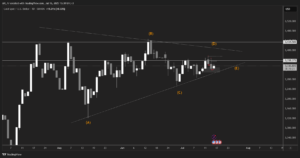The US Economy Grew by 2.9% in the Fourth Quarter of 2022, Ignoring Looming Recession Fears.
The US economy ended 2022 in good shape, even as questions persist about whether growth will turn negative next year. The gross domestic product for the fourth quarter of 2022, which is the sum of all goods and services produced from October to December, increased at an annual rate of 2.9%.
Economists polled by Dow Jones had expected a reading of 2.8%, but the quarterly growth was slightly slower than the 3.2% in the third quarter. Consumer spending increased by 2.1%, down slightly from 2.3% but still positive.
The personal consumption expenditures index rose 3.2%, in line with expectations but fell sharply from 4.8% in the third quarter. Excluding food and energy, the index rose 3.9%, down from 4.7%.
A Sudden Decline in US Jobless Claims
Unemployment claims declined in the US during the past week, contrary to expectations of an increase. According to data from the US Department of Labor, jobless claims in the United States decreased to 186 thousand during the week ending on the twenty-first of January, compared to 192 thousand applications in the previous week. This is the first-time orders have fallen below 200,000 for two consecutive weeks in 9 months. Analysts had expected jobless claims to reach 293,000 levels.
On the other hand, unemployment benefits applications recorded 197.5 thousand applications over the past four weeks, which constitutes a decline of about 9.2 thousand applications compared to the week ending on the 14th of January.
Oil Continues to Rise Supported by US Positive Economic Data
Oil prices rose slightly on Friday, January 27, extending their gains for the second session in a row, supported by vital US economic data and increasing hopes for a demand recovery after the Chinese economy’s reopening. Brent crude futures rose 30 cents, or 0.3%, to $87.66 a barrel. US crude futures rose 21 cents, or 0.3%, to $81.22 a barrel. Both benchmarks rose more than 1% on Thursday, and Brent is on track for a second weekly increase if gains continue.
The improvement in the GDP and inflation data in the United States gives a glimmer of hope that the US Federal Council may slow down the pace of raising interest rates, which reduces fear of contraction in economic activity and the consequent demand for oil.
Meanwhile, the Centers for Disease Control and Prevention said this week that the number of severe COVID-19 cases in China fell 72% from a peak this month, while the number of hospitalized patients fell 79%. These numbers indicate the return of the Chinese economy to normal, reinforcing expectations of a recovery in oil demand.
Intel’s Quarterly Revenue Fell by 32%.
Intel reported profits and revenues below analysts’ expectations during the last fiscal quarter of 2022. Adjusted earnings per share came in at 10 cents, compared to Refinitiv’s expectations of 20 cents. Revenue came in at $14.04 billion, below expectations of $14.45 billion. Intel’s revenue declined by 32% year-on-year, marking the fourth consecutive quarter in which the company’s sales declined. The company also incurred net losses of $664 million, compared to profits of $4.62 billion in 2021.
According to “Pat Gelsinger,” the company’s CEO, Intel, will not disclose its expectations for the entire year due to the current uncertainty, indicating that the company will deal with economic headwinds during the first half of this year at least.
Client Computing Group’s revenues, including computers and chips, fell 36% to $6.63 billion. Revenue from the data center and artificial intelligence unit fell 33% to $4.30 billion.
US Indices Continue their Gains, Supported by Corporate Earnings.
US indices ended Thursday’s session in green amid many conflicting economic data after announcing the performance of the US economy for the fourth quarter and US companies continuing to announce their financial results and earnings, in addition to anticipating the US Federal Reserve’s decision on interest rates during the following week.
The data showed the gross domestic product in the United States had grown at a robust pace of 2.9% and above expectations in the fourth quarter of 2022. Consumer spending rose at a solid annual rate of 2.1% in the fourth quarter but at a lower rate than in the previous third quarter, which amounted to 2.3%.
However, many economists still expect a significant slowdown in US GDP growth in the year’s first quarter, especially since high borrowing costs will lead to a possible recession due to shrinking consumer spending and lower investments.
The Dow Jones index rose by about 200 points, or 0.6%, recording the fifth consecutive daily rise. The index also stayed above the 50-day moving average of 33,621 points after closing at 33,949 points. The S & P 500 index rose by more than 1% to close at its highest level in about two months, supported by achieving profits higher than expectations for about 69% of the companies that announced their results. The Nasdaq Composite Index jumped by 1.8%, reaching its highest close in 4 months, with direct support from Tesla stock. The index was able to close near its 200-day moving average of 11,516 points.
Tesla shares jumped by 11%, achieving its highest daily gain in more than a year and recording the highest closing since mid-December. The company announced revenues of $24.32 billion in the fourth quarter, compared to expectations of $24.16 billion—adjusted earnings of $1.19 per share.
Disclaimer: This article is not investment advice or an investment recommendation and should not be considered as such. The information above is not an invitation to trade and it does not guarantee or predict future performance. The investor is solely responsible for the risk of their decisions. The analysis and commentary presented do not include any consideration of your personal investment objectives, financial circumstances, or needs.





